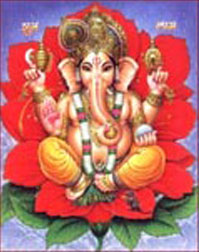“Maha Lakshmi Namastute Divya Kamala Lochane,
Sankha Chakra Gada Haste Maha Lakshmi Namastute”.
~ Lakhmi Puran
Gaja Lakshmi, is a manifestation of Goddess Lakshmi – as Gaja Lakshmi she is the Goddess of Elephants – symbol of represents Power, Strength, Grace and Fertility.
Gajalakshmi Puja starts from Ashwin Purnima or Kumar Purnima (Full Moon day in Ashwin month). However at a few places it is also observed on Shukla Paksha Dasami in Bhadra.
Goddess Gajalakshmi is one of the Ashtalakshmi (eight aspects of Goddess Lakshmi). The others being – Adi Lakshmi, Dhana Lakshmi, Dhanya Lakshmi, Santana Lakshmi, Veera or Dhairya Lakshmi, Vijaya Lakshmi and Vidya Lakshmi. She is the most powerful Goddess among the eight aspects. She is the one who brought back all the wealth lost by Indra. She is also the Goddess of cattle. The festival is also associated with the birth of Goddess Lakshmi. There is a popular belief that whoever keeps awake during night would be blessed with wealth and prosperity. Card games are particularly popular method of staying awake. She is four-armed, clad in red garments, she carries two lotuses, other two arms in abhaya mudra and varada mudra and she is flanked by two elephants bathing her with water pots.
Gaja Lakshmi is believed to be the giver of animal wealth like cattle and elephants. Swami Chidananda interprets Gaja Lakshmi as giver of power of royalty. According to Hindu mythology, Gaja Lakshmi brought back the wealth lost by Indra (king of demi-gods) from the ocean.
In Orissa this day coincided with Kumar Purnima. According to the mythology, “Kumar” or “Kartikeya” was an extremely handsome of Lord Shiva. He was born on the full moon day in the month of Ashwin. maidens seek the blessings of Lord Kartikeya to have a handsome life partner in life.
Actually the legend of Goddess Lakshmi is the legend of Samudra manthan. Rishi Durbasha cursed Indra to lose all his wealth and when Indra apologized he said that Lord Vishnu would undo the damage. With Lakshmi power, wealth, enthusiasm and radiance left the demi gods. In time the gods lost their immortality and valour. As demonic power occupied the heavens sage Brihaspati with Lord Brahma appealed to Lord Vishnu. He suggested churning the sea of milk. Cutting long story short ambrosia appeared which gave the gods immortality and extremely beautiful and radiant Goddess Lakshmi emerged and restored Indra to his position. She is Gaja Lakshmi.
Gaja Lakshmi Puja is the longest festival celebrated in the Dhenkanal and Kendrapara, Orissa. Here Lord Ganesha and Goddess Lakshmi are worshipped. It continues for eleven days. The practice started in 1923 at Kunjasahu Chowk (now Ganesh Bazaar). The entire town is decorated. The Polishree Mela organized by the district administration and cultural programs add charm to the festival. In 2010 Gajalakshmi Puja will be celebrated in October 22nd in Orissa.
Idols of the Goddess are installed and worshipped. Devotees observe fast on this day. Offerings are made to the Sun God. And in the evening, food offerings are made to Moon and the fast is broken. The festival has special significance for maidens. They play a special game called ‘Puchi on Kumar Purnima day.
Toshali Resorts invites you to witness and celebrate this year Gaja Lakshmi Puja Festival on October 22nd in Orissa, which is observed for 11-days. For Gaja Lakshmi Puja Festival Reservation Package You can also contact your travel consultant for more details.
If you feel, we have missed any information that is helpful for your friends visiting this blog, do post your comments and conversation.
